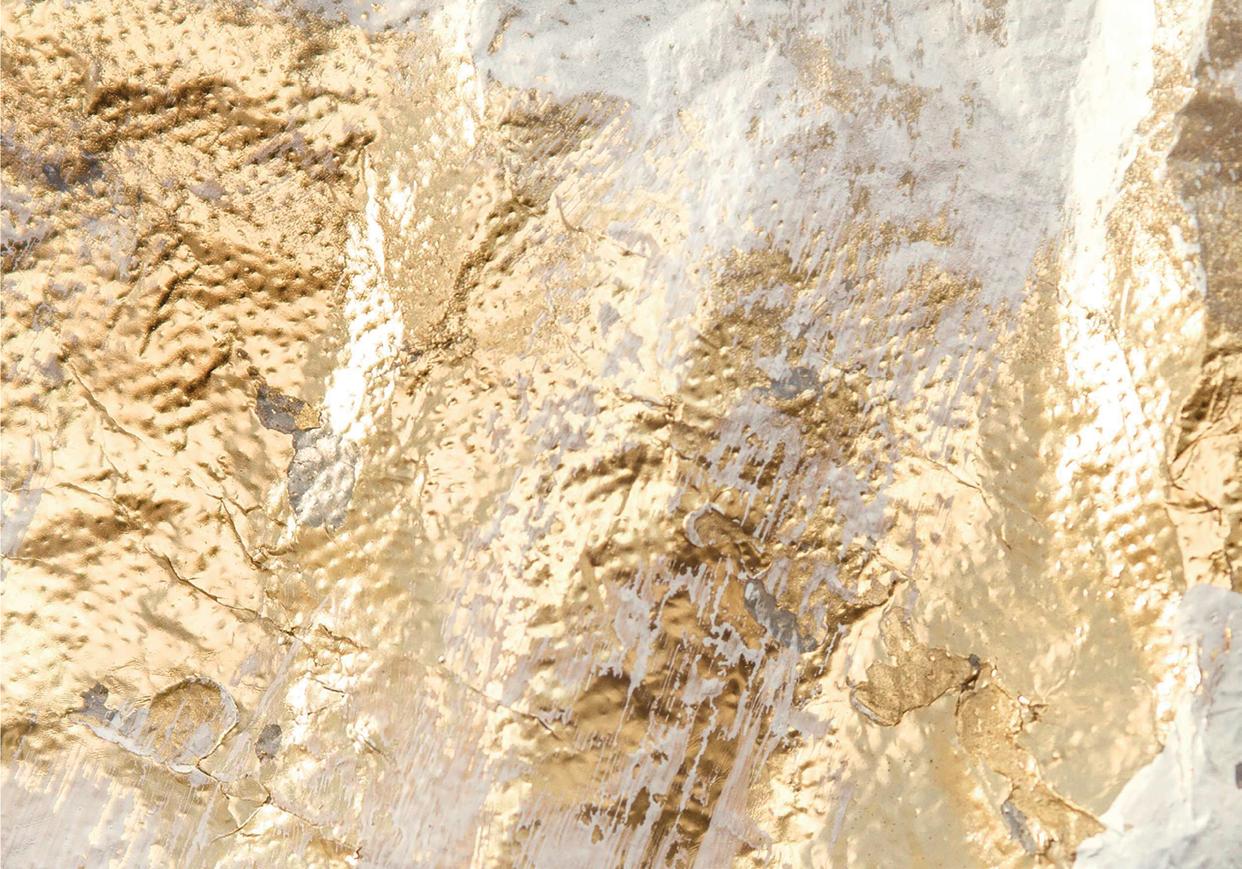

BE YOURSELF
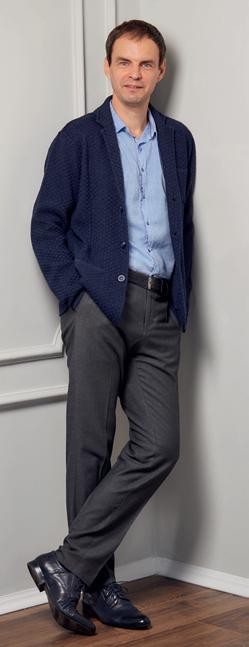
I am Sergey Denisov, founder of the DENISOV brand and owner of Denisov Art Studio. I consider 1998 to be the year of the foundation of the brand – the year when I started working in this field, although there was no name at that time. The idea of branding came later, from customers who asked why I did not put a logo on my unique products. Over time, there was a commercial need to create a brand; it was needed to increase the recognition of my works. This is how the history of the DENISOV brand began.
However, let us start from the beginning. I was born in an ordinary family in the highest mountain city of the Urals –Zlatoust. I grew up with two brothers. Mom was a medical worker; dad was a senior refrigeration foreman.
Since childhood, I have loved to make, to create everything with my own hands. For example, toy boats that floated, I invented a lot from papier-mâché, I especially liked working with wood. Moreover, painted a lot.
I studied well at school, but I lacked of discipline and perseverance. My favorite subject was history (I especially liked to study the countries of the East, Africa and South Asia), and I got only A's. The love of art also came through history. One day, the whole class went to St. Petersburg (then Leningrad), to the Hermitage, and many of the exhibits made an unforgettable impression on me, especially the sculptures. Then I tried to use sculptural forms in my works.
Physics also fascinated me, especially when we studied the mechanisms, disassembled them.
After graduating from high school, I entered the Chelyabinsk State Polytechnic Institute and received a degree in mechanical engineering. Although the dream was to go to study at a theater university, at the directing faculty. I love theatrical art, and at school, I studied in a theater circle. Nevertheless, my parents insisted on getting a more "reliable" profession. It was important for mom that her children had higher education.
While studying in my first year, I became interested in the craft that was developed in our city – metal engraving. This craft turned out to be interesting, besides it gave an opportunity to earn money. The study of engraving was at the same time a knowledge of the history of the native land, craft traditions that had deep roots, and the opportunity to try to do the same as the masters did many centuries ago, because for 300 years the manufacturing technology has not changed.
DENISOV MAGAZINE
I received my very first order at the age of 18, when I was studying at the institute. My studies were formal, as I often skipped classes because of work. There was a threat of expulsion from time to time, but thanks to my active participation in public life, they made concessions to me. For me, the most interesting thing in my student days was participating in KVN (club of Fun and Resourcefulness), organizing various events and performances. While studying, the institute was renamed three times. By the end of my studies, it became known as South Ural State University, so I joke that I graduated from three institutes.
Serious work began with the recommendation of my friend, who showed my products to his friend from the North. He turned out to be an employee of an oil and gas company looking for a gift to his boss. When he saw my work, he appreciated it highly, and we began to cooperate. I remember this time with warmth. The orders were interesting to make, and the payment was good.
Over the years, I have created works that I did not want to give to anyone, because it is simply impossible to repeat them. Previously, if a product did not find its owner for a long time, it confused me, I began to notice that something could be improved or done differently. Now the products of my brand are getting many fans from all over the world and with each piece, I understand that every Jack has his Jill.
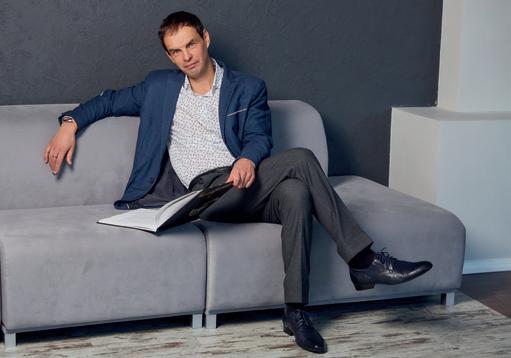
Serious work began with the recommendation of my friend, who showed my products to his friend from the North. He turned out to be an employee of an oil and gas company looking for a gift to his boss. When he saw my work, he appreciated it highly, and we began to cooperate. I remember this time with warmth. The orders were interesting to make, and the payment was good.
Over the years, I have created works that I did not want to give to anyone, because it is simply impossible to repeat them. Previously, if a product did not find its owner for a long time, it confused me, I began to notice that something could be improved or done differently. Now the products of my brand are getting many fans from all over the world and with each piece, I understand that every Jack has his Jill.
In general, products live their own special life. It happens that you create a sketch, but in the process of creating a work, cardinal transformations occur (up to a change of concept), and as a result, it is a completely different work. This does not apply to approved orders; everything is going as agreed with the customer.
The time from idea to realization is also impossible to calculate to the minute. The idea can be formed quickly, and I can create a sketch of the product in a day. But also can be that the idea can take many months to appear. Then there is already a technical, production moment. Today, there are no impossible tasks, there may be difficulties associated with the implementation of a specific idea. Sometimes it takes three months to coordinate the sketch, and the product is created in a month. And sometimes, on the contrary, the sketch is ready in a week, and the production of the order stops for various reasons. According to my observations, this is often connected to the energy of the customer, with his attitude to life. The timing also depends on the complexity of the product, on what materials are needed for the work. The delivery of raw materials can take a month (when ordering materials from Africa, for example). Now there are enough opportunities to choose any rare and noble materials.
According to my observations, this is often connected to the energy of the customer, with his attitude to life. The timing also depends on the complexity of the product, on what materials are needed for the work. The delivery of raw materials can take a month (when ordering materials from Africa, for example). Now there are enough opportunities to choose any rare and noble materials.
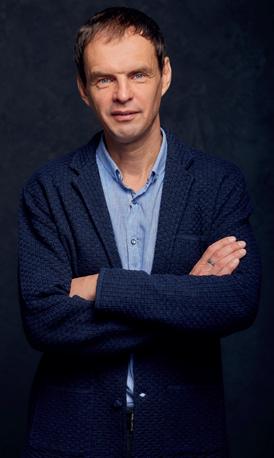
The most interesting ideas come from traveling. When you study the culture of other nations, you notice a lot of interesting ideas and think about how it can be adapted to our work. Making notes, sketches in audio recordings, taking pictures of something, and sometimes spontaneously, at night, insights come. In addition to new ideas, there is an opportunity to see new materials when traveling. When I first visited Madagascar, I was fascinated by oceanic jasper. Up to this moment, I was sure that Ural gems were the best in the world.
I am a happy person because I am doing what I love. What is especially important to me is that I have the opportunity to fulfill myself. I am also pleased to realize that pure, bright, divine energy flows through our products, which activates people's sense of beauty. Realizing this gives you strength and helps you not give up when it is difficult. I often notice how in the process of working on products, a transformation takes place in the minds of our customers, their aesthetic taste improves. In general, more people are able to appreciate works of this level and understand the importance of our work, which is very encouraging and inspiring.
As for the selection of employees, an important point for me is to understand that you are on the same wavelength with a person. Then the work processes are noticeably simplified, the employees understand what I want them to do and how best to implement it. I have a few guys who understand me perfectly, literally in some kind of telepathic way. When such people come to the company, I always thank God. I take it as a blessing. I think I deserve something, since there are such people in my life.
Over the past years, we have formed a team of professionals. However, I am always looking for talented people. Sometimes life brings them together by itself. The process of working with people is always interesting. I like to get to know their worldview and attitude. It is interesting to find a common language, to understand each other. There are specialists who left us at the time and are now working for themselves. We turn to them when we receive large orders or a technologically complex operation is ahead. I understand that it will take more time for our masters to do this than for a higher-level master who once worked for us.
To avoid boredom, we involve designers from other fields and countries in the creative process. They offer their vision of the idea we have proposed, which we can rework. It is a fresh look, and it is always interesting. One day, as an experiment, we gave two of our designers and three experts from other countries ideas, and they offered their vision. As a result, we made two amazing products from all the proposed sketches. The essence was the same, but the execution was different, and it was incredibly interesting – unity in diversity and diversity in unity. I also like to attract young designers; they have a completely different, unusual vision
We are working on several collections of our works that will be available to private and corporate clients. Each collection is a creative search that stimulates development, inventing new things.
I like to come up with new things, generate unique ideas. I want to see my works fresh and original.
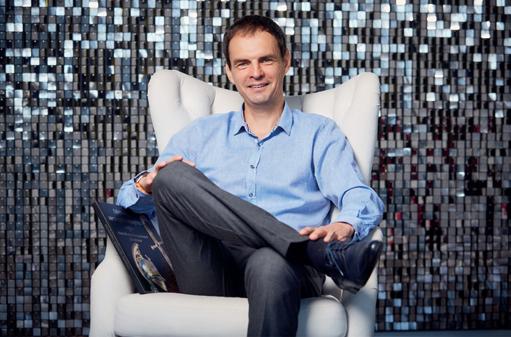
Over the years, I had to get up and fall many times. However, in our life, everything is not as it seems. What is bad for us now may turn out to be good after a while, and vice versa. We must accept everything that life gives us, keep balance and be in the flow. It gives harmony, lightness of being. It is also important to remain yourself. What is inherent in us the divine spark, and the power of the spirit must be preserved.
There are both positive and negative qualities in each individual. The most interesting to me as an example are businessmen who achieve success without changing themselves, their principles.
I understand that there is nothing permanent in this life. In recent years, drastic changes have been taking place in the world, and if you avoid transformation, adaptation to new trends of the time, you may find yourself unclaimed. Time encourages you to be a marketer, to learn how to combine creative and commercial components. This has its advantages. You learn many of the unknown, new neural connections develop, which contributes to the manifestation of creativity in new aspects. Everything is accelerating in the universe, on the planet, and there is a large flow of information in general. Even in our work, new technologies and new equipment have appeared which we are implementing. We definitely gain time by applying innovations. However, at the same time, our task is to preserve the individuality of the brand and introduce the world to the unique vision and my Denisov products.
LEAVE A MARK
My name is Artyom Popov, since 2014 I have been an entrepreneur, the owner of a successful business and since 2023 a partner of Denisov Art Studio.
I owe my success not only to my personal qualities, but also to my family, close friends who always believe in me and support me, as well as fate, which constantly gives favorable circumstances and meetings with amazing people.
I will start my story from afar. My ancestors from my father’s side ended up in Kazakhstan at the beginning of the twentieth century. My great-grandfather, an architectural engineer, was forwarded to Almaty (at that time, the city of Vernyi) for the construction of the famous Ascension Cathedral. Later, his family moved to Kyzylorda, which was then the capital of the Kazakh Autonomous Socialist Soviet Republic. Ancestors fro, my mother’s side were transported from Ukraine to Tashkent during the starving in 1933 and stayed there to live.
My grandfather from mother’s side studied in Tashkent, where he met my grandmother. He was the eldest of three children, and the only one who graduated from university. He was a hydraulic reclamation engineer in Kyzylorda, when Alma-Ata became the capital; he was transferred along with the state institution where he worked. My father graduated from the border guard college and was the commander of the border guard post on the border of Turkmenistan and Iran. A year after my birth, in 1984, my family had to move to Alma-Ata, since service in a remote area with a small child was no longer possible.
My grandfather from mother’s side, Mikhail Ivanovich Bochkov, is a legendary figure in our family. He worked in the Ministry of Ecology and Bioresources and made a huge contribution to the construction of large state–scale facilities that have become significant for the whole of Kazakhstan, such as the dam above the Medeo high-altitude skating rink, the Great Almaty Canal, several water intake structures, etc. He was involved in the protection of water resources and the conservation of fauna in the protected areas of our country. Despite the responsible position that my grandfather held, he often visited us. We were looking forward to his appearance. A personal driver brought my grandfather in a black Volga; he was always in a suit, neatly combed and full of energy. He had an excellent speech and a phenomenal memory, grandfather was a wonderful storyteller, and listening to his endless stories was a pleasure. He was much respected in our family; grandfather was the bearer of family values and traditions, thanks to him they were passed on to us organically.
My father is a man with a capital letter and a great example for my brother and me. I am sure that the world is built and maintained on such people, and families with such a man are reliable and stable. The 90s of the last century were quite difficult, and my father, like many former military men, had to work several jobs to feed his family. He left very early, came in late and was pretty tired, but despite this, he found the strength and fatherly warmth to spend time with his sons.
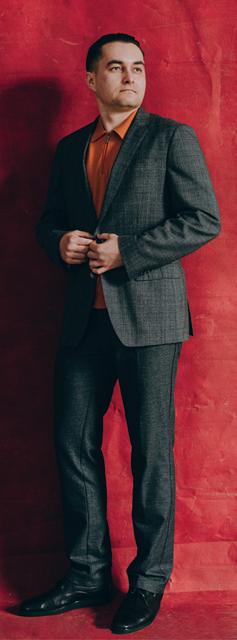
DENISOV MAGAZINE
I will start my story from afar. My ancestors from my father’s side ended up in Kazakhstan at the beginning of the twentieth century.My great-grandfather, an architectural engineer, was forwarded to Almaty (at that time, the city of Vernyi) for the construction of the famous Ascension Cathedral. Later, his family moved to Kyzylorda, which was then the capital of the Kazakh Autonomous Socialist Soviet Republic. Ancestors fro, my mother’s side were transported from Ukraine to Tashkent during the starving in 1933 and stayed there to live.�
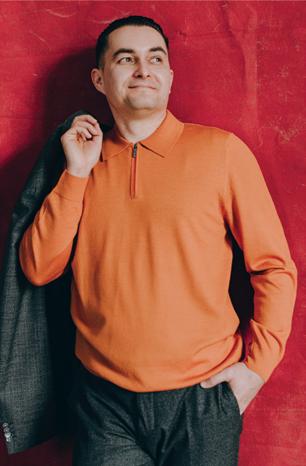
On weekends, we went to visit our grandparents, and this constant ritual gave the life of our whole family a calm and solid. The trips to them were also interesting from an aesthetic point of view. In the grandfather's house, sets, statuettes, vases were real works of art, they were brought from foreign business trips or given by work colleagues who had excellent taste for such unique things. I grew up surrounded by all this beauty, but I did not understand its value. These things pleased my eye, I liked them, but I took them for granted.
I was lucky with school too. We lived near the I.V. Panfilov Gymnasium No. 54, and while many parents dreamed of arranging their children there, I got into this school, inaccessible to many, by a micro-district. This is one of the oldest schools in Almaty, which was opened in 1938, and the strongest teachers of the city have always worked in it. In the late 90s, the school organized physical and mathematical, chemical and biological, economic and humanitarian education profiles, dance clubs, chess, a chemical laboratory were opened, and a ballroom dance ensemble was created. As part of the ensemble, I participated in ballroom dancing competitions among Almaty schools, performed in theaters and at city events. We were often taken to museums, exhibitions, we learned several foreign languages, practiced martial arts – in short, school life was incredibly eventful.
My mother was engaged in my and my brother's upbringing and family life, before she plunged into entrepreneurship with my father. It is possible to write a separate book about her, as well as about my grandmother (her mother). By the way, my grandmother was a cardiologist, and I was born on the day of the medical worker (the third Sunday in June). Everyone said that thefuture
the future doctor was born. In general, mom and grandma were everything to us (men in the family)! There is nothing more to add.
When I graduated from the 8th grade, we moved to another area. Not far from our new place of residence there was a multidisciplinary gymnasium No. 134, which many Almaty students also dreamed of getting into. Thanks to my studies at the 54th gymnasium, I had a strong base, and at the very first entrance exams, I scored the points necessary for admission to the Department of Mathematics and Computer Science. My new class was friendly, cohesive, and the teaching staff was on top, creating a sense of a friendly family. We are still in contact. The only drawback was the need to leave swimming, which I had been enthusiastically engaged in since the third grade. Instead of swimming, basketball came into my life, which stayed with me for a long time.
After graduating from high school, I entered the Kazakh State University. I did not particularly like studying at the Faculty of Law, at that time I lacked the cultural component to which I had become accustomed during my school life. One day I met with a graduate of the 134th gymnasium, over a cup of coffee she told me about her studies in Germany, and I got excited about the idea of studying there.
I managed to inspire my parents with this idea and started learning the language. In a year and a half, I learned the basic level of German with tutors, and contacted the university. The first time I was refused, but that did not stop me, and the second time I already received an invitation.
And from 2003 to 2010, I studied in Germany. First at the Faculty of German and European Economic Law, then at Business administration. At the universities of Jena and Siegen, I became even more immersed in art, poetry, and architecture. It is easy to enjoy architecture in Europe; almost every city is beautiful and distinctive. I longed to see and feel this beauty.
In Germany, not only buildings are being built for centuries. There I learned how to build relationships with new people for business or friendship based on honesty, integrity, openness, flexibility – simply, for the ages!
Despite the fact that I have been in Germany for 7 years, I have not been able to travel all over Europe. The budget was limited, I had to earn extra money during the holidays, and my studies were stressful. Nevertheless, I always found time to visit museums, galleries, and exhibitions. The love of art, laid down in childhood, made itself felt. When I came to St. Petersburg on an exchange from Germany, the beauty of this city also fascinated me. However, Peterhof gave the most vivid impressions.
In 2010, after writing my diploma work, I went home to rest and immediately received a job offer. There were offers in Germany too, but I decided to return to Kazakhstan. It took time to adapt. After 7 years of living and receiving higher education in Germany, I had to "re-learn Russian". This was especially true of professional terms. I worked for the German engineering company KVL Consult, participated in the construction of the international transit corridor "Western Europe – Western China". We provided consulting support to banks, construction companies, and international organizations. I was at the center of all the events, because I was the only one who knew both German and the local mentality, and spoke three languages. I worked in this company for four interesting years, realized that I could no longer work for someone, and went into business.
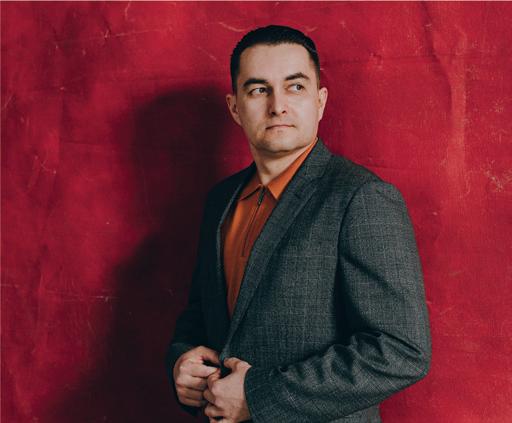
DENISOV MAGAZINE
The first project was implemented together with my school friend, who returned to Kazakhstan after graduating from Moscow State Technical University and subsequently opened his own business – importing confectionery and bakery products in shock freezing from Europe and selling them in the b2b segment. Together, we tested the b2c segment by opening a Roolet store in the central part of Almaty. Despite the fact that I worked almost 24/7 and a year and a half were simply cut out of my life, the project inspired me. Customers were delighted when they saw our assortment, tried completely new flavors of desserts and freshly baked pastries. This was my first practical step into entrepreneurship, we set up this project and sold it to an Almaty resident who graduated from pastry chef in France and wanted to continue what he started, but cook according to European recipes adapted to local raw materials. By the way, he made masterpieces!
It is worth to note that when I was in elementary school, my father became involved in entrepreneurship, and over the following years, my parents' business reached a good level. They invited me to their place so that I could bring fresh ideas. I hesitated for a long time, but decided to try it anyway. Over time, I also established my own company, separated and began to develop it in accordance with his vision. Everything was going well it worked perfectly. But I lacked the emotional component that I once received from the pastry shop, seeing our satisfied customers and the explosion of their emotions. My main business is – this is industrial chemistry, mainly the b2b sector. Everything is supplied and sold in large volumes – tons, wagons, and there is no aesthetics in this.
In 2021, I started thinking about opening a new business to diversify. However, I already wanted to open a business for the soul, self-realization, perhaps a completely different profile. In entrepreneurship, as in life, it is first necessary to close the basic needs, and only then, there is a desire for self-actualization. And if the desire is very strong, the opportunities come by themselves.
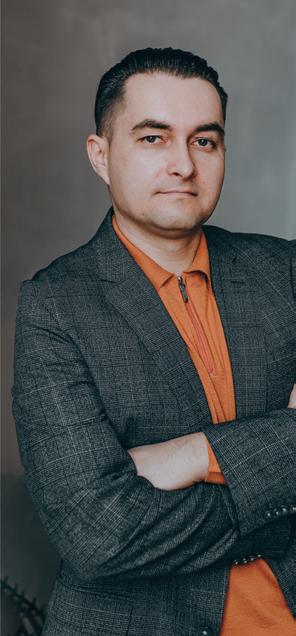
In 2021, I started thinking about opening a new business to diversify. However, I already wanted to open a business for the soul, self-realization, perhaps a completely different profile. In entrepreneurship, as in life, it is first necessary to close the basic needs, and only then, there is a desire for self-actualization. And if the desire is very strong, the opportunities come by themselves.
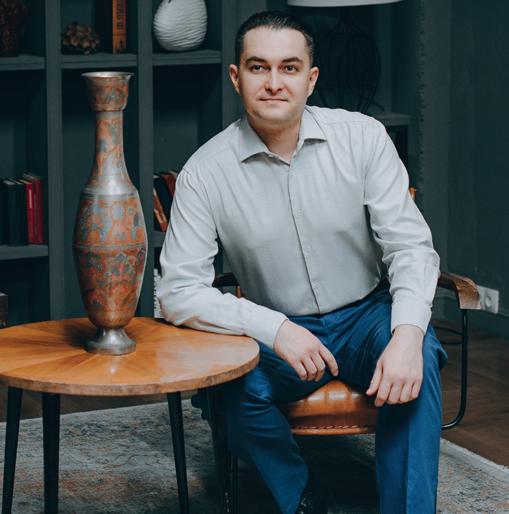
And in the summer of 2021, I met Sergey Denisov. Prior to that time, he had been living in Almaty for several years. He had his own store, but then he returned to Russia. After returning, he still had regular customers, and he had to visit Almaty very often. At our first meeting, Sergey had one of his products with him – a pocket printing equipment that delighted me. Then Sergey sent his booklets. I looked at his website and was amazed by the products presented; it was such an impeccable combination of style, craftsmanship, and materials. Literally the next day, Sergey flew away, and I was left, on the one hand, in complete admiration of what I saw, on the other on the other hand, with some doubts. Everything was so perfect that it could not be true. To dispel doubts, I flew to Zlatoust in early 2022. Sergey showed me a production facility where the craftsmen really did everything by hand. He introduced me to his team. He took me to local history museums, told me about the Urals itself, about stonecutters, about Ural gems. I came back inspired and seriously thought about it. I have been gathering information for a long time, delving into it, trying to figure out how best, thinking about whether I need it. Over the years of entrepreneurship, different things have happened, and caution has appeared. I am more the one who measures seven times than the one who rushes into the pool with his head and figures it out along the way. Then a confident decision was formed: I will do this; I want this brand to be known all over the world.
What is also important, I liked Sergey as a person, as an individual, immediately, at the first meeting. He seemed honest, open, and trustworthy to me. We are similar in many ways, despite the difference in characters and temperaments, understand each other on an intuitive level and move in the same direction. This synergy of professional skills and personal qualities strengthens our union.
DENISOV
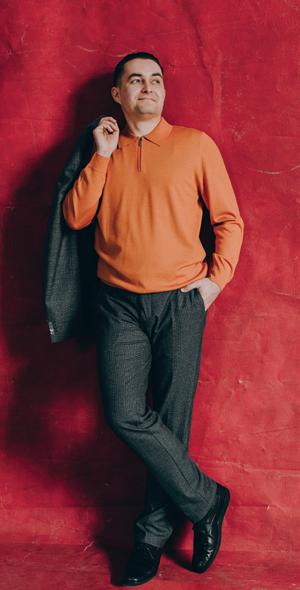
It is fascinating that Sergey is so passionate about his business that his inspiration and fullness are transmitted to others, recharge them. He is a true professional who has been doing what he loves all his life, and this is very valuable. Listening to Sergey's stories about the formation of his business, I realized how close it was to me. We build many processes in the same way: we study everything thoroughly, test it, and only then delegate it. Otherwise, we complement each other to some extent. I learned how to create a business, optimally build processes, get maximum results, at the same time, since childhood, I have a love for beauty. Sergey has a more developed creative component. He can notice the interesting sides of life see almost imperceptible nuances and embody them in his products, but he also managed to create and put his business on track, he also has the makings of a businessman. However, I cannot create such beautiful things, and Sergey has not yet found a companion who would help expand the company's range and reach the world level. Apparently, fate wanted us to meet and together we went into the development of our strongest qualities to create something that has the right to remain in the centuries, so that our descendants could see these unique objects of applied decorative art, tell their children about them, pass from generation to generation.
Our partnership is aimed at the future and should bring excellent results, because in the first place a good goal is to instill love for the beautiful and leave a good memory for posterity.
Our partnership is aimed at the future and should bring excellent results, because in the first place a good goal is to instill love for the beautiful and leave a good memory for posterity.
In the middle of 2023, we opened an official representative office of Denisov Art Studio in Kazakhstan, and began to introduce our brand to Central Asia. In June 2023, we were in Qatar and had substantive discussions with partners who represent our interests. What is pleasing is that all the products that were taken as samples were sold. The delight that people felt when they were seen is impossible to describe in words. Such a reaction inspires and motivates further cooperation. In addition, we would like to increase the awareness of the Denisov brand in as many countries as possible, so that connoisseurs of exclusive products have the opportunity to have these works of art in their collections. We have big plans for 2024 – entering new markets, meeting new partners and, of course, creating unique, luxurious products under the Denisov brand. People should see this beauty, feel the soul of the master, touching it products created by hand, and get aesthetic pleasure from contemplation, realizing that Denisov – it is not works of art, Denisov – it is art.
STAR OF THE EAST
Sergey Denisov's hometown is a city with a rich tradition of creating edged weapons. Zlatoust is famous all over Russia for a weapons factory built more than two centuries ago, where gunsmiths from the German city of Solingen worked. Their products became exhibits of museums, and traditions of creation are passed from generation to generation. Zlatoust metal engraving is no longer just a decoration for dirks, swords and sabers, but an art form that unites generations in the endeavor to preserve traditions. Sergey Denisov became interested in this craft as a teenager, and for many years improved his skills in order to reach the pinnacle of mastery and give his products a unique master's handwriting, which we can trace in the «Star of the East» and his other works of art.
In ancient times, the bladed weapons of the East were rightly considered one of the best in the world. Their unusual shape, variety, elegance of finishing and incredible craftsmanship were admired. The exotic weapon in the shape of a crescent moon, capable of cutting even a silk handkerchief in the air, was legendary. In addition, the weapons of valiant and noble warriors were inlaid with precious metals and stones and had a blade of Damascus steel, which aroused even more interest in them.
To this day, sabers and daggers made according to ancient technologies and traditions of the East are the most expensive bladed weapons in the world. They are the pearls of private collections and the pride of their owners.
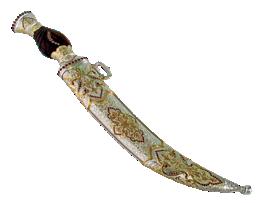
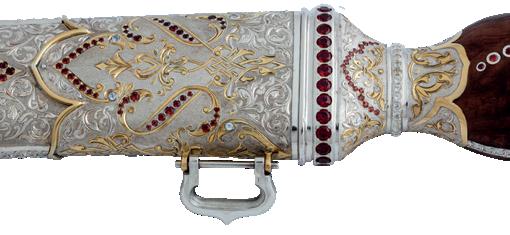
In ancient times, the bladed weapons of the East were rightly considered one of the best in the world. Their unusual shape, variety, elegance of finishing and incredible craftsmanship were admired.�

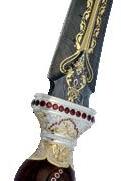
DENISOV MAGAZINE
The «Star of the East» set fascinates from the first glance. Even the case is an art object worthy of attention. Its upper part is decorated with a laconic oriental ornament, which is characterized by a combination of plant patterns and geometric motifs. The bronze clasps of the case are decorated with the finest carving. These motifs, but in inverted form, are repeated many times along the edges of the case, which gives the whole composition integrity and completeness. Made of leather, stylish and keeping a flair of mystery, the case "promises" the foretaste of a miracle, an unseen oriental fairy tale that lurks inside. And intuition does not fail. When you open the lid, you can feel unprecedented emotions in the widest spectrum - from delight and amazement at the products themselves to admiration for the craftsmanship and the highest artistic taste of the creator who made this magnificent luxury. There is a desire to look at every detail, every millimeter of these works of art. Yes, these are truly masterpieces worthy of becoming the bright stars of private collections!
The saber and dagger are created in the style of traditional bladed weapons of the East and are decorated with metal engraving. The handle of the dagger is made of walnut root, the same wood is used for the hilt of the sabre. The blades on both sides are decorated with decorative oriental ornamentation made by galvanization with gold of the highest grade.
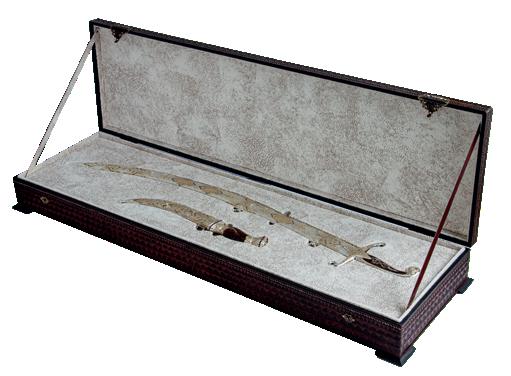
Faceted topazes and garnets decorate the scabbards of sabers and daggers. Delicate patterns sparkling with silver and gold are created in the arabesque technique. The ornamentation is characterized by high aesthetic properties and sufficient complexity of compositions. The decoration is made with the use of repetitions, which are based on strict mathematical calculation of the elements of the pattern, with one fragment as if flowing into another. Such a composition excludes the use of background, but in this case, with the help of three-dimensional fragments and stone inlay, the master was able to distinguish between the main and background elements, which gave the traditional technique a modern sound and increased the exclusivity of the product.
The handle of the saber is decorated with large garnets and ornaments. On the walnut insert, the pattern takes on different motifs than the ornaments on the scabbard, forming a sacred figure eight - a symbol of the infinity of the universe and everything in it. The hilt itself resembles a horizontally stretched four-pointed star, giving the name of the set a completely different meaning.
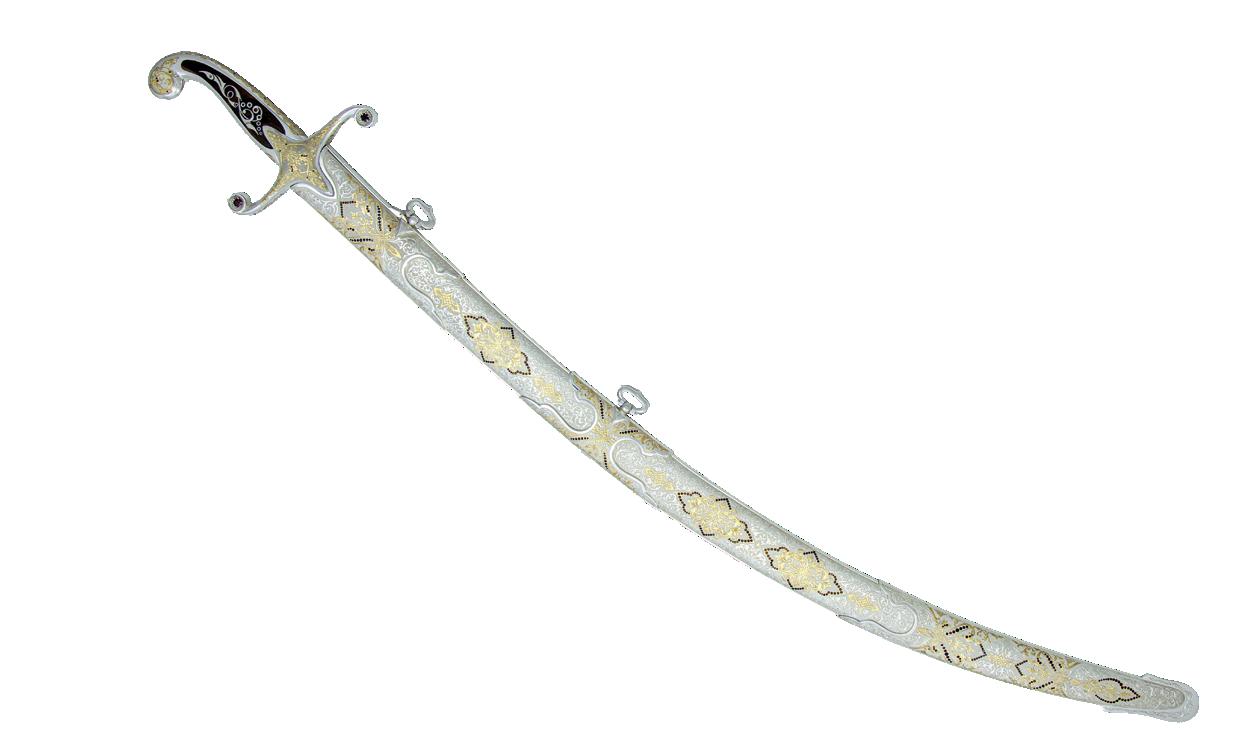

The handle of the saber is decorated with large garnets and ornaments. On the walnut insert, the pattern takes on different motifs than the ornaments on the scabbard, forming a sacred figure eight - a symbol of the infinity of the universe and everything in it. The hilt itself resembles a horizontally stretched four-pointed star, giving the name of the set a completely different meaning.
The blades are made of Damascus steel, which gives them a luxurious and elitist look. It is impossible to see such a pattern as on Damascus blades on any other steel! It is truly unique. Even on dagger and saber blades, the layering of metal and its intensity are different, emphasizing the uniqueness. The handle of the dagger is decorated with a large garnet, which gives the product completeness and restrained-elitist style.
Made in a single copy, the «Star of the East» is worthy to become a jewel of the collection or the first and the main exhibit in it. Embracing incredible aesthetic feelings, it will also emphasize the masculinity and respectability of its owner and will become a real guiding star in the world of unique works of art!
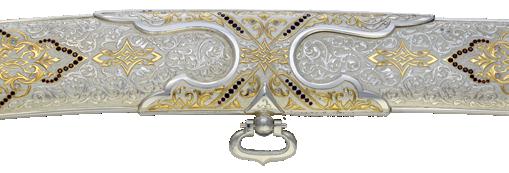
MATERIALS:
DAMASK: wild, stainless steel (X40Cr13- X160CrMoV12-1), gauge 5.5 mm thick
METAL: sterling silver not less than 925, weight 1320 g, 24 karat gold
WOOD: walnut root in wax
Stones garnet almandine 8.3 carats
Topaz stones colourless 33.2 carats
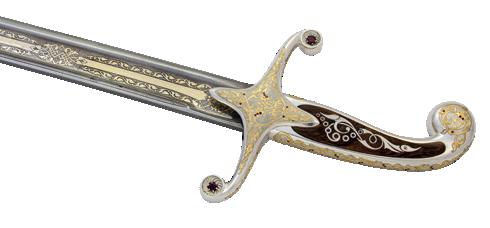
SABRE "THE WAY OF THE WARLORD"
The artist Sergey Denisov comes from Zlatoust. It was here, at the very beginning of the 19th century, that the famous Russian arms factory was built, and the art of engraving on metal has even deeper roots. It is not surprising that the artist, who grew up surrounded by centuries-old culture and armory traditions, is fascinated by the manufacture of bladed weapons.
Sergey Denisov has studied the history of his native land for many years, learnt all the nuances of making edged weapons and added a unique vision to his works, combining the traditions of Russian craftsmanship with the luxury of oriental stylistics. We can trace this combination of two cultures in the artwork "The Way of the Warlord" and other works of the master from this series.
So long ago that the mountains had time to get lower and some stars to go out, sabers appeared in the East. They gained popularity among warrior-riders and were an invariable attribute of a man's life, playing the role of a reliable and faithful defender.
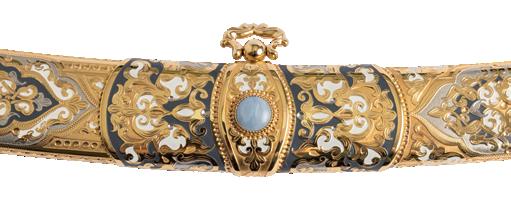
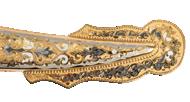
Sabers of noble warriors were inlaid with gold and silver. The blades were produced by multi-layered technologies, complicated, but worth it - they provided the product with durability.
Since then and up to our days, sabers are a symbol of courage, strength, bravery and a valuable gift that almost every man dreams of.
At all times sabers were a sign of respect and personified the power of their owner. If earlier they were presented to representatives of the nobility, nowadays they have become works of art, and collectors have a rich arsenal of cold weapons. And one of the most perfect types of bladed weapons and the center of private collections is rightly considered to be a Sabre.
Keeping and multiplying the traditions of the legendary masters of the past, the bladesmiths of Denisov Art Studio create true masterpieces that even time has no control over.
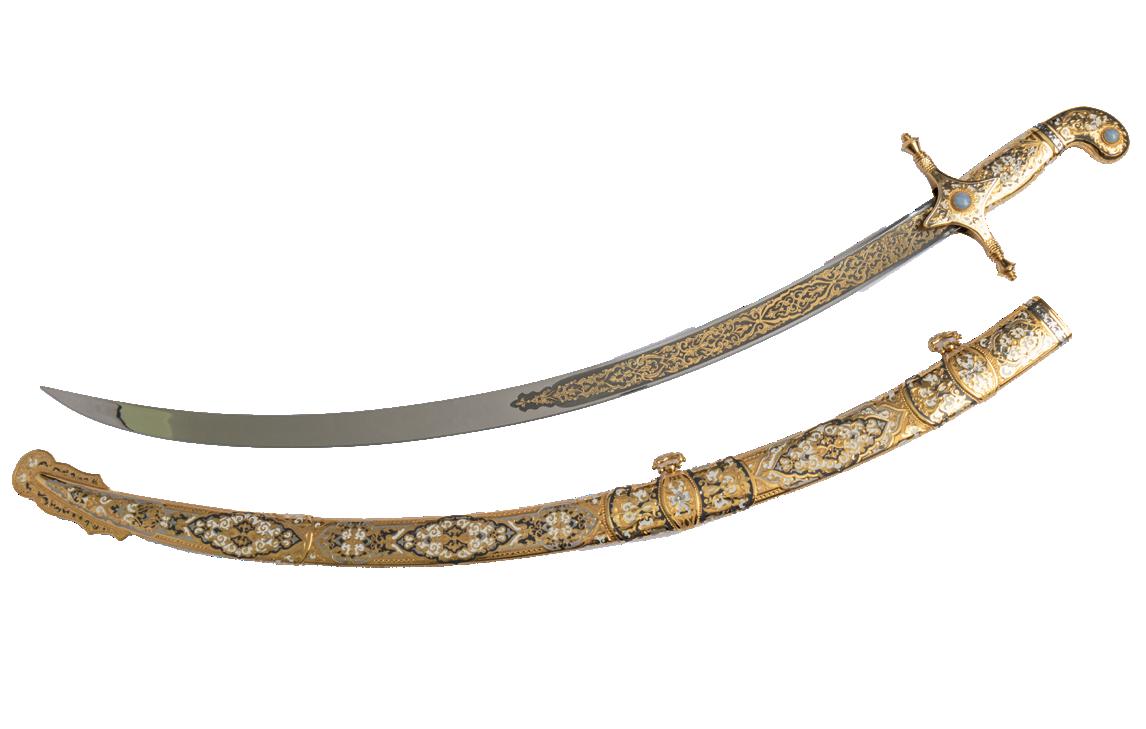

For example, the Eastern-style Sabre "The Way of the Warlord" with its name alone can emphasize the high status of its owner - a leader capable of strategic thinking, creating and leading.
Made in a single copy, it is truly unique in every motif decorating it and in the whole compositional idea as a whole. The intricate oriental ligature, electroplated in gold of the highest grade, is applied to the blade on both sides. The asymmetrical hilt fits perfectly into the curve of the palm of the hand. It is inlaid with large agates and serves as a starting point for the motifs repeated on the scabbard. The traditional oriental ornaments decorating the scabbard impress with their flawless patterns and their graceful transitions from one to another, symbolizing the infinity and interconnectedness of everything in this world.
The unique technique of manufacturing allows you to get a highly artistic work that is not subject to the influence of time. The Sabre "The Way of the Warlord" will not only emphasize the high status of its owner, but will also become the center of the collection and a piece of elite art, capable of preserving the memory of centuries and the continuity of generations.
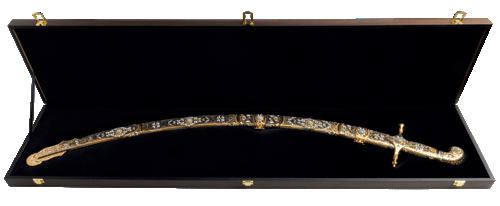
MATERIALS:
Bronze, 24kt gold plating, silver plating, agate, high-alloy steel 110Х18

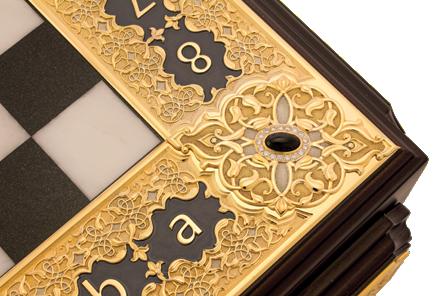
CHESS "BATTLE OF
BABYLON"
Artist Sergey Denisov has been fascinated by history since childhood. He was particularly interested in the countries of the East, Africa and South Asia. This fascination over the years only intensified and was reflected in many of the master's works. This is how a series of exclusive chess games dedicated to famous battles was created. Each of these logical games made by Denisov Art Studio is unique in its own way, but the "Battle of Babylon" has a special place. This work of art conveys the warlike spirit of that epoch and the greatness of the event that imprinted in history the name of the founder of the mighty Persian power.
The fact that Cyrus would become the ruler of the world was predicted even before his birth. Information about the childhood of the future king varies, but all historical sources are unanimous in describing his victories and conquests.
With acquisition of a royal throne Cyrus the Great began to expand the possessions, having grasped the Midian kingdom. The campaign against rich and powerful Lydia was also crowned with success. Cyrus' army then conquered Caria, Lycia, and all of Asia Minor.

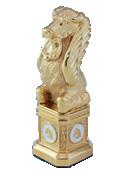
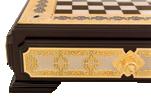
All that remained was the most powerful and coveted possession of Babylonia, a great power that controlled the Tigris and Euphrates valleys, Syria, Palestine, Arabia, and the trade routes to Egypt and the West. Babylon was a thriving metropolis, the center of civilization and the 'capital' of the world. For Cyrus, defeating Babylon was especially significant. He wanted to become the most powerful ruler, to immortalize his name in history, and he succeeded.
The confrontation between the two powers did not last long. In August 539 BC in the battle near the city of Opis the Persians forced the Babylonians to flee, in early October Sippar was captured without a fight, and a few days later they were able to enter Babylon along the riverbed, which they had diverted, having previously dug 360 channels.
The desire to capture the historic battle between Persians and Babylonians at Opis on the Tigris, when Cyrus the Great won a victory over Belsharruutsur, the stepson of King Nabonidus, the loudest in his life, inspired the artist Sergei Denisov to create the "Battle of Babylon" chess set.
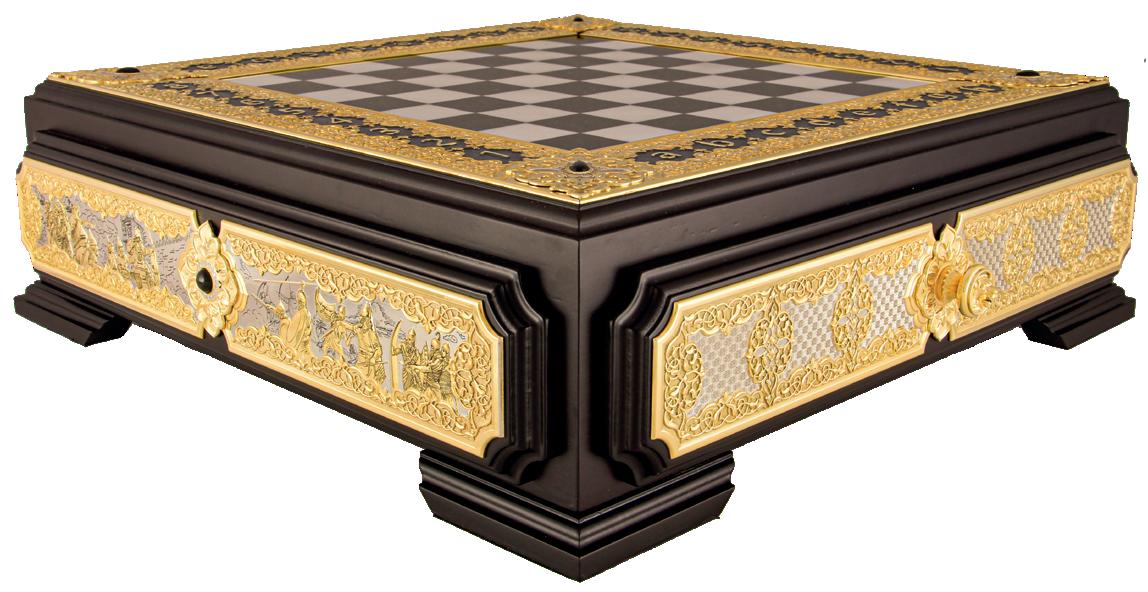
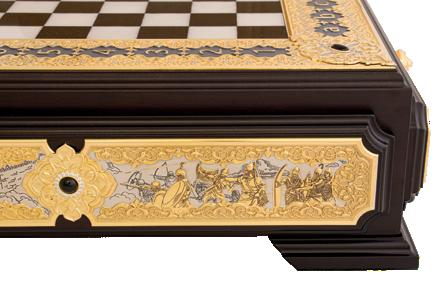

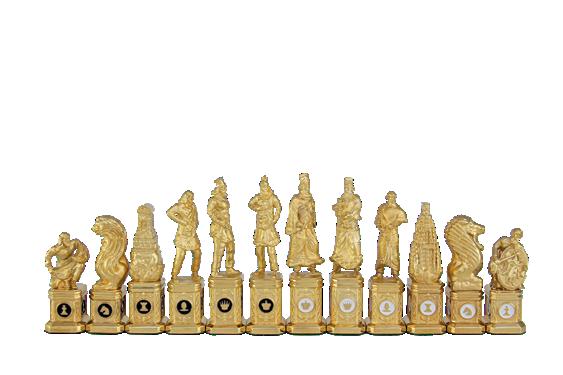
The desire to capture the historic battle between Persians and Babylonians at Opis on the Tigris, when Cyrus the Great won a victory over Belsharruutsur, the stepson of King Nabonidus, the loudest in his life, inspired the artist Sergei Denisov to create the "Battle of Babylon" chess set.
Unusual chess pieces are presented in the form of two armies: white - Persian under Cyrus the Great and black - Babylonians under Belsharruutsur.
In those times, the Babylonian army consisted of lightly armed troops and chariots. The master was able to convey this lightness not only through weapons - daggers, crescent-shaped shields - but also through shortened robes, giving the figures of Babylonian warrior’s lightness. In contrast to them, the Persians look more substantial, their clothes falling almost to the ground, metaphorically conveying the strength and power of the Persian power, which had already defeated more than one state. There were many archers in the Persian army, the warriors defended themselves with round shields - and even these nuances were taken into account by the artist Sergei Denisov when creating the chess pieces. On the heads of the royals are crowns, in the scabbards are swords made with an accuracy worthy of admiration.
The rooks and horses of both armies attract attention due to the unusual nature of their depiction. The rooks, made in the shape of towers, are both a figment of the author's imagination and a reference to the famous biblical legend about the construction of the Tower of Babel. As for the chess horses, their embodiment is even more surprising. Researchers have noted that in the times of the Babylonian kingdom there were images of mysterious statues, some kind of hybrid creatures. It is these creatures that are present in the armies of Persians and Babylonians as a kind of totems, capable of bringing victory to the warriors.
The chess pieces are made of bronze, symbolizing strength and majesty, covered with 24 carat gold, which gives them luster and luxury, and inlaid with jeweled enamel. Absolutely every detail of this unique piece, even the smallest, is handmade.
The chess board is crafted from Italian marble, which creates a strong and stable base for this work of art. The stone battlefield is decorated with a gilded bronze border with bas-relief carvings and silver niello, creating exquisite contrast and detail.
On the border of the chess field, scenes of battles framed by Byzantine ornamentation, like newsreel footage, convey the intensity of that great battle. In a manner typical of Sergey Denisov, the events are shown in dynamics, allowing us to become their participants, to feel the energy of the battle and the speed of passing events.
With the help of gilding and silver blackening the artist managed to distinguish the foreground and background and to give the depicted fragment of the battle scale and volume.
The image of the battle is divided by a lotus flower - a symbol of change. This author's solution also has another purpose: the flower, located in the center, divides the battlefield, allowing us to see two armies - the attacking Persians and the defending Babylonians.
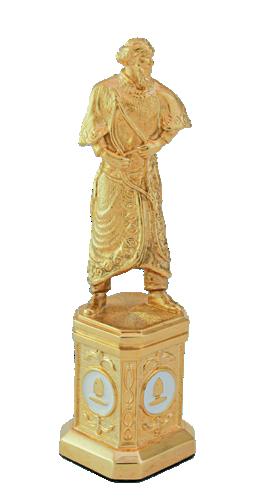
The image of the battle is divided by a lotus flower - a symbol of change. This author's solution also has another purpose: the flower, located in the center, divides the battlefield, allowing us to see two armies - the attacking Persians and the defending Babylonians.
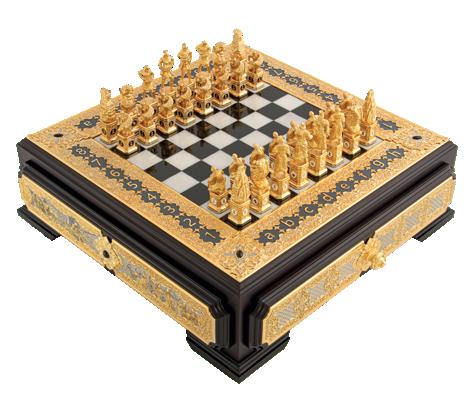
The ornate Byzantine pattern is decorated with inserts of obsidian and colorless topazes, recalling the greatness and wealth of the two powers. The obsidian inlays, harmonizing with the black marble, symbolize the strength and power of each power. Moraine beech combined with black stone gives the whole piece a refined and elegant feel.
The chessboard has pull-out drawers with a separate place for each piece, allowing them to be carefully stored. The handles of the drawers are made in the form of lions' heads - guards guarding the metaphorical doors to the places where troops are stationed.
Embodying the greatness and power of the ancient powers and embodying in the present a great event of the past, the "Battle of Babylon" chess game is a work of art that one wants to enjoy every day, while playing the game discovering new facets of the masterpiece created by the artist Sergey Denisov and feeling himself a strategist who could compete with Cyrus, but the times are not the same.
However, the outcome of the Battle of Babylon has long been known to everyone. But who will be the winner on this magnificent field is decided only by the skill and intelligence of the opponents. And every time the outcome of the battle can be different, which gives the game of chess endless mystery, and the game of chess, which is a unique work of art, also aesthetic pleasure, which can be felt not only by you, but also by your descendants, touching the elegantly made, weighty pieces that keep the warmth of touch and energy of more than one generation. .
MATERIALS:
Bronze, 24kt gold plating, silver plating, porcelain, colorless topazes, obsidian, mortared beech, Italian marble, enamel.
CLASSICAL CHESS
It is not by chance that artist Sergey Denisov has created a whole collection of exclusive chessboards based on historical events. It's in his blood. The great chess player, international grandmaster Anatoly Karpov is a close relative of the master. Sergey Denisov himself enjoys playing chess. His genetics and passion for this logical game are reflected in the classical chess pieces created in the master's unique manner.
The history of chess goes back centuries. And the game itself is recognized as the game of generals, kings, emperors and the creative elite. The origin of chess is shrouded in mystery, but it is no secret that this game allows you to develop logic, analytical skills, concentration, memory and you can play it endlessly. That is why chess has always been a welcome gift.
There are many versions of the origin of chess: according to one, the rajah got tired of eternal wars and campaigns and ordered to invent for himself a game that could replace his usual hobbies. Chess became such a game. According to another, the rajah received chess as a gift from a high-ranking subject while collecting tribute: the latter decided to give the ruler wisdom instead of gold.
Centuries have passed, but chess still remains a status gift. It is especially valued by intellectuals and professional players.
In the past, chess was a privilege of aristocratic families, it corresponded to the status of rulers and nobility. The game was a part of important negotiations, during which agreements and contracts were signed, laws were drafted, and military strategies were developed. Therefore, such a gift expresses respect to a person and emphasizes his intellectual abilities and high status.
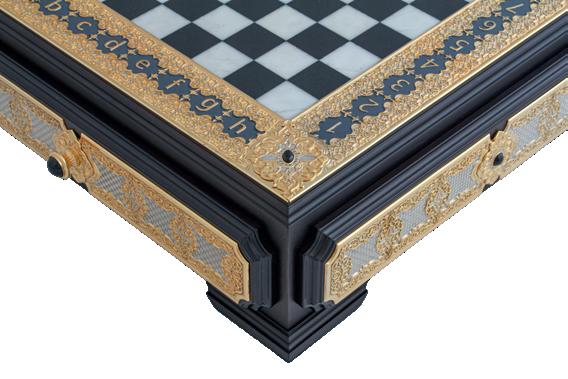
The history of chess goes back centuries. And the game itself is recognized as the game of generals, kings, emperors and the creative elite. The origin of chess is shrouded in mystery, but it is no secret that this game allows you to develop logic, analytical skills, concentration, memory and you can play it endlessly. That is why chess has always been a welcome gift.
DENISOV MAGAZINE
At one time, stylish playing pieces and a chess table inlaid with natural stones were an ornament of any palace or estate. Nowadays Denisov Art Studio revives traditions, creating original, exclusive chess pieces worthy of the highest dignitaries. Each work of art from this series has its own history and carries a deep philosophical meaning and aesthetic load.
Figurines of the gift set "Classical Chess" are made of bronze and Italian marble and covered with gold. Due to the combination of marble and bronze each figurine has a tangible weight. It is pleasant to hold it in your hands, feeling how the cold stone gets warmer and seems to come to life, helping you to win. The use of marble in figurines of classic form gives them a new content - bright and individual. This laconic luxury emphasises its simplicity and elegance.
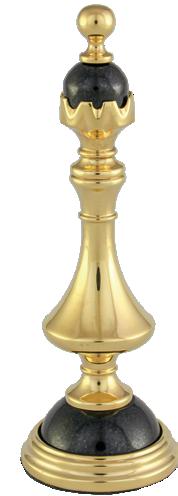
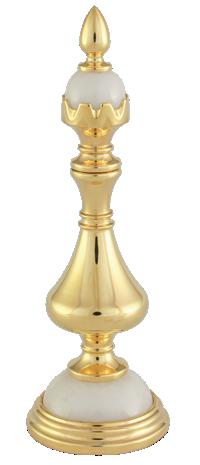
The chessboard battlefield, made of the rarest Italian marble, is framed by a gilded bronze border with bas-relief carvings. On it, traditional oriental patterns are repeated many times, passing from one to another with mathematical precision and blossoming into large flowers, with obsidians framed by transparent topazes in the centre.
This artistic move emphasises the harmonious combination of obsidians with black marble and dark moraine beech, of which the chessboard is made. It features pull-out drawers with a separate storage space for each piece, which will keep them looking immaculate for a long time.
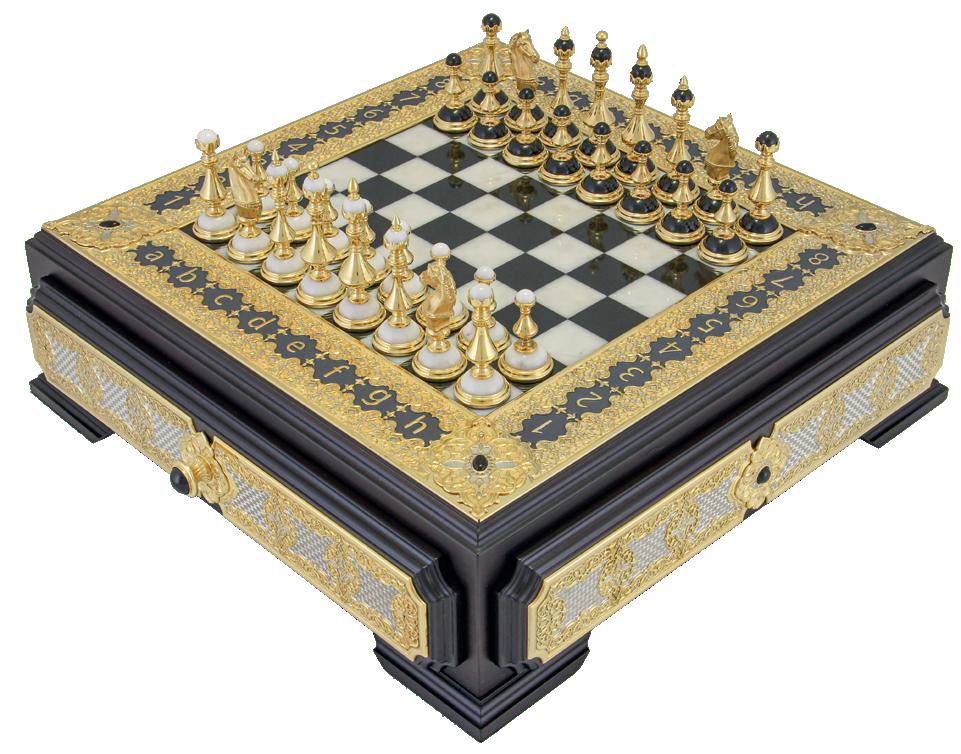

This gift set can become a heirloom that will be handed down from generation to generation as one of the main family values. It will develop your descendants' logic, intelligence and give a sense of the deep roots of your ancestors who took care of a legacy that is valuable both artistically and spiritually.
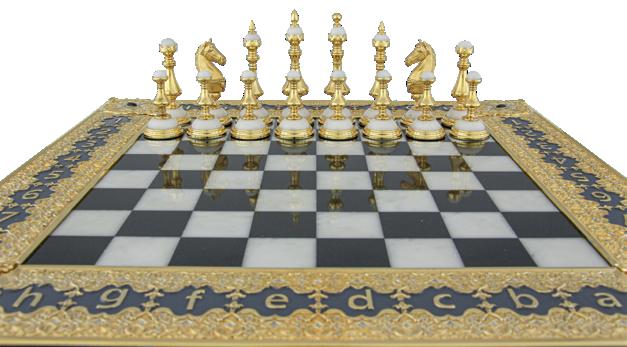
MATERIALS:
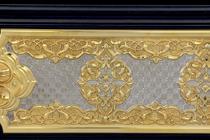
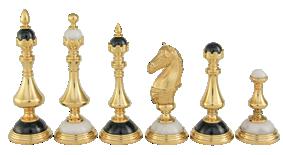

JEWELRY BOX
"DESERT ROSE"
The culture of East and West, a drop of African exoticism and the genius of the master - the conditions ideal for the creation of a masterpiece. It was in such conditions that the Desert Rose blossomed - a work of art that captivates connoisseurs of beauty at first sight.
Some places have an amazing ability to activate the talents of geniuses. It is as if they give an energy impulse, and a new, previously unknown reality emerges, which the master embodies in stone and metal. This is how a masterpiece is born.
During a trip to Abu Dhabi, the capital of the UAE, artist Sergey Denisov was inspired by the grandeur and luxury of Sheikh Zayed's snow-white mosque; its inherent airiness, despite its monumentality, and the delicacy of the ornate floral ornamentation decorating the front walls and ceilings of the mosque.
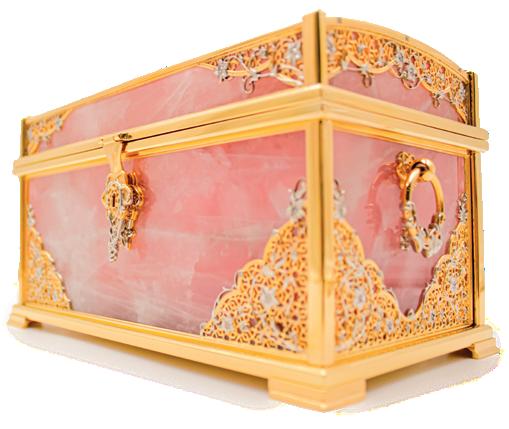
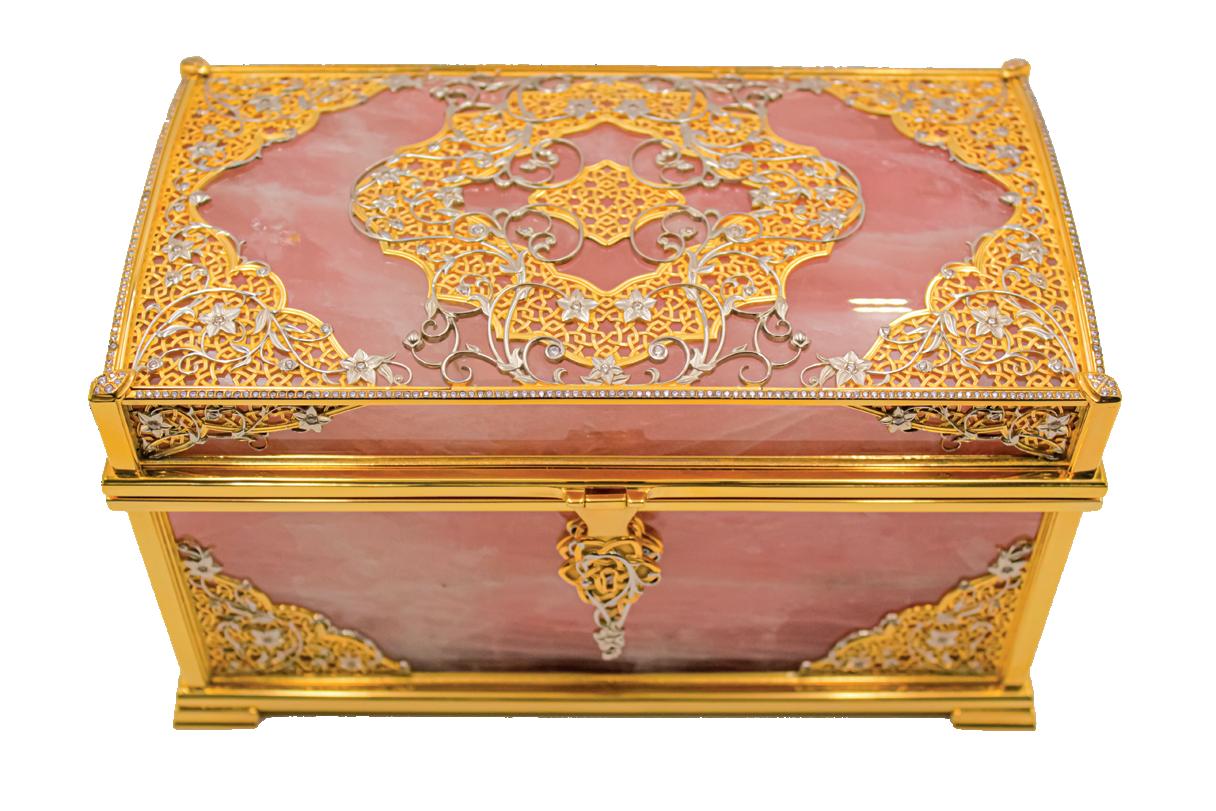

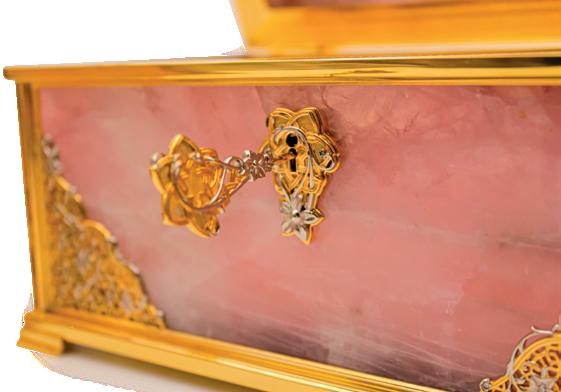
A trip to Madagascar provided the material for the creation of «Desert Rose» - rose quartz. As delicate and airy as the snow-white marble of the Great Sheikh's mosque.
And the idea of the whole interior set - a box and a photo framewas born thanks to the mysterious beloved of the master, as beautiful and harmonious as rose-colored quartz, and as delicate as a rose, whose bud symbolizes eternity.
Men like to surprise, delight, please their women and give them gifts. And those that evoke all these emotions at once and remind their owner of love, generosity and impeccable taste of the beloved man on a daily basis.
Thus, the Great Tamerlane and the last Emir of Bukhara left to their descendants architectural structures that remind them of their feelings for their loved ones. Cherchez la femme, as the French say: if a man does something significant, it is for the sake of a woman. And exceptional men give gifts equal to their greatness.
Times change, but traditions remain the same. Men in love like to gift their women, and luxury goods and art are still the top gifts to give.
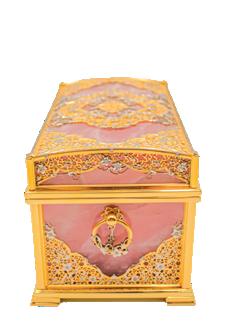
DENISOV MAGAZINE

The interior set «Desert Rose» declares without words the feelings of the giver and the care with which he surrounds the love of his life. Amazing rose quartz and openwork, visually seeming weightless ornamentation, are tenderness and love elevated to the absolute.
The box and frame are united by a single style, expressed in the repetitive motifs of floral ornamentation, located around the perimeter of the bases of all the objects and revealing itself in all its elegance on the foot of the photo frame. Thanks to the filigree oriental ornamentation, the stone products seem almost weightless. With all its unique beauty, each item also has a utilitarian value.

The interior set «Desert Rose» declares without words the feelings of the giver and the care with which he surrounds the love of his life. Amazing rose quartz and openwork, visually seeming weightless ornamentation, are tenderness and love elevated to the absolute.
Eastern architects built mosques and palaces, which we admire to this day, on the orders of rulers. The products created under the Denisov brand make it possible to leave a modern cultural heritage in the centuries and daily evoke bright and pure emotions in their owners, especially in the only one to whom this exclusive gift is intended.
MATERIALS:
Madagascar rose quartz, bronze, 24kt gold plated, silver plated, colorless topaz.
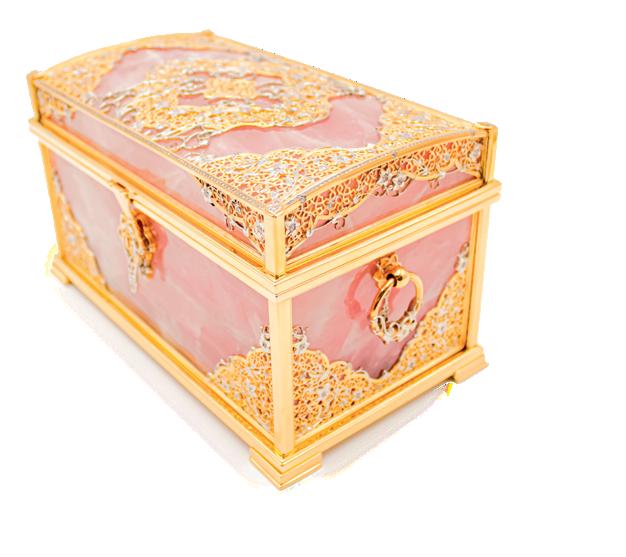
SET "DESERT ROSE"
The idea for this interior set was given to artist Sergey Denisov by Atmos watch - a unique masterpiece of the Swiss brand Jaeger-LeCoultre.
The ingenious master, using beautiful Madagascar rose quartz and filigree ornamentation, managed to give the watch the tenderness inherent in objects of a woman's interior, and complemented the set with a photo frame and a box made in the same style. Creating this work of art from idea to realization took a long time, but the result was worth it!

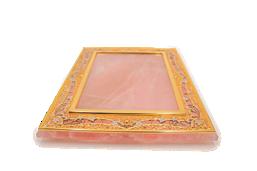
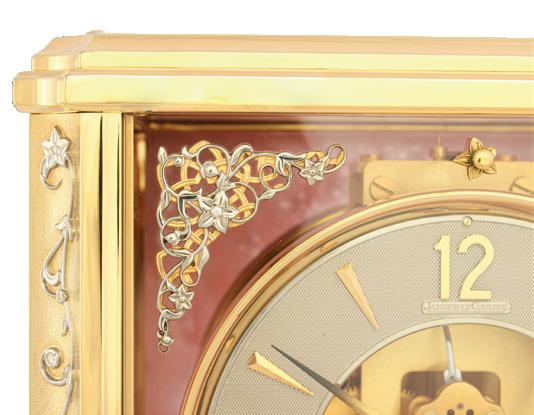
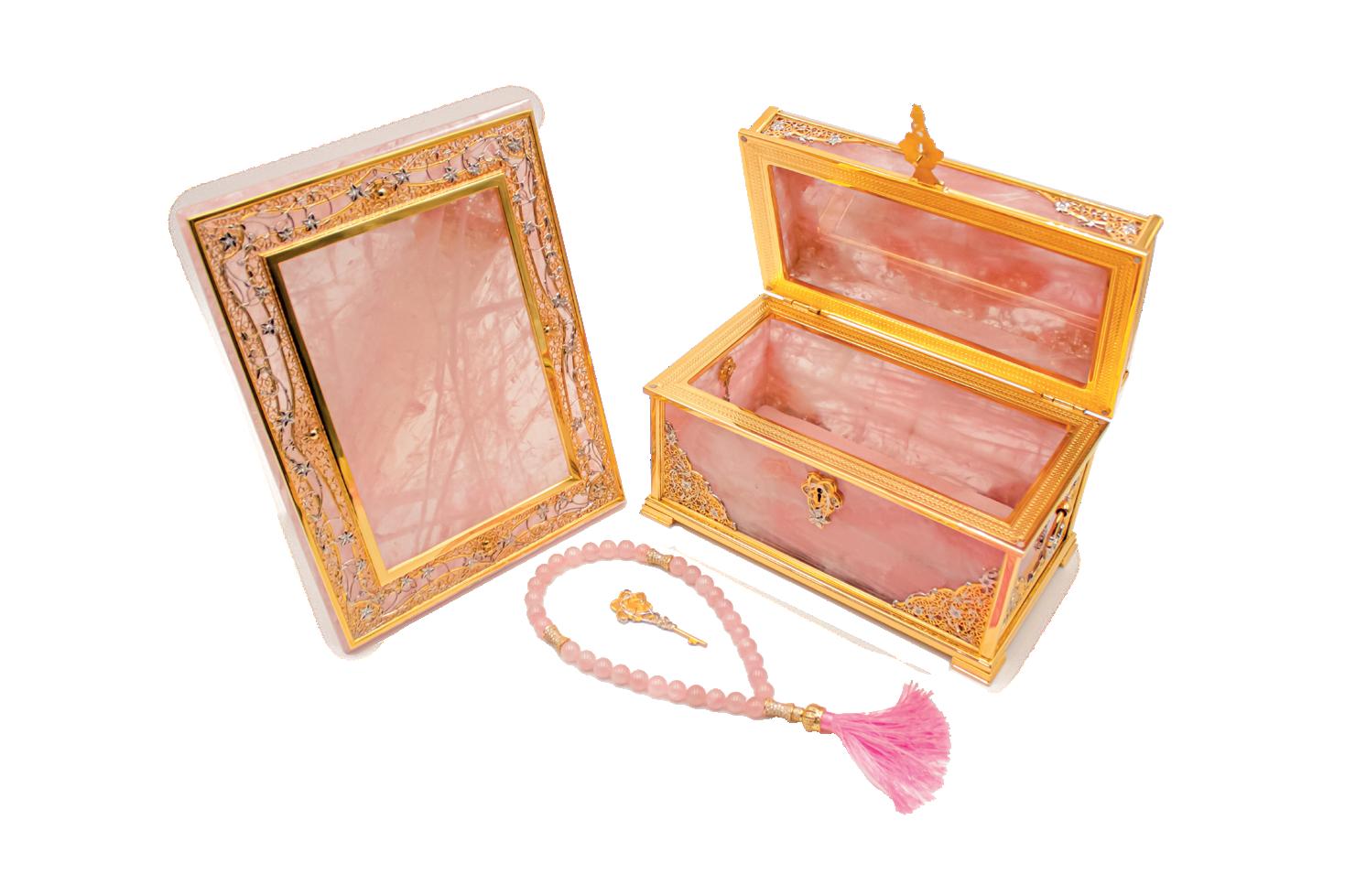

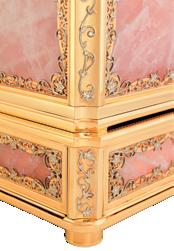
Interior set "Desert Rose" is created to become a unique gift, without words speaking about the depth of feelings and reverent attention with which a man treats his beloved. Each piece in the set is a frank story about tenderness, which can be easily read in the main material - pink Madagascar quartz, and in the ornament, so filigree that creates the illusion of its weightlessness.
The casket, frame and watch are made in the same style. Ornament framing unites all the items compositionally, emphasizing the uniqueness of each piece. The floral pattern is located around the perimeter of the bases of all the items, graceful triangles are woven along the bottom of the box and the front part of the clock, and only on the leg of the photo frame it is completely straightened by a graceful and flexible stem. Thanks to the delicacy of ornate oriental ornament, made by hand, stone products acquire lightness and airiness.
And even the clock reminds not of the transience of time, but of the meaning of existence and the value of every minute. Their drawer is as if created for storing rose quartz rosary beads to thank the Creator for the joy of life and its splendor at a set time.
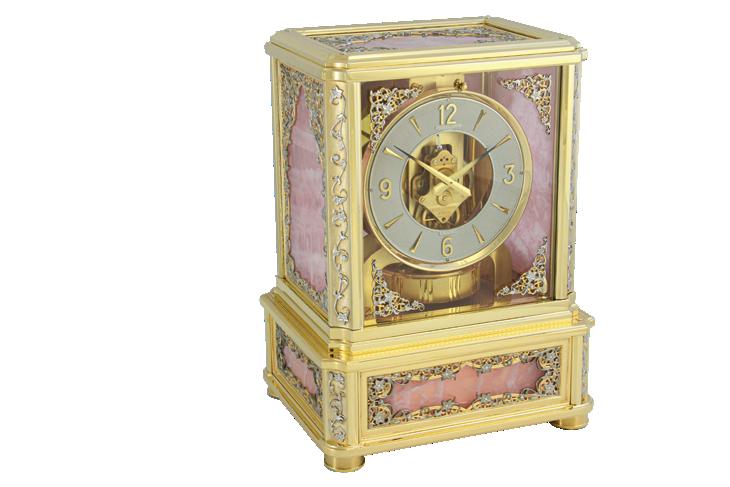

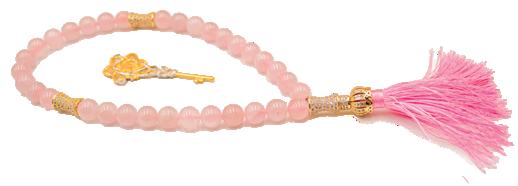
The watch is also unique in that it combines Eastern traditions and advanced Western technologies. Following Leonardo da Vinci's dreams of a perpetual motion machine, Swiss engineer Jean-Léon Reuter invented the Atmos watch, capable of drawing energy from atmospheric changes. This particular timepiece is encased in a frame of rose Madagascar quartz. Multilayered oriental lace exquisitely decorates the stone, and the luster of transparent topazes emphasizes the elegance of the floral motifs.
"Desert Rose" - a gift worthy of a queen, and a memory that will be kept by your descendants, telling the beautiful love story of their ancestors.
MATERIALS:
Madagascar rose quartz, bronze, 24kt gold plated, silver plated, colorless topaz.
The size of the box (L*W*H): 23cm*13cm*13cm.
Photo frame size (H*W*D): 25cm*19cm*10cm.
Watch size (H*W*D): 22cm*18cm*13cm.
KORAN
Denisov Art Studio pays tribute to the symbol and the main miracle of Islam - the Koran.
Religion is a form of consciousness, and in the world of art, religious motifs are a source of deep inspiration. They give birth to works that are incredibly strong in their emotional content and possess deep hidden symbolism.
At the end of the 6th century, the Prophet Muhammad was born in Mecca. This name is known not only to those who profess his teachings, but to practically every educated person. Muhammad's sermons made up the Holy Book of one of the world religionsIslam.
The Koran is the holy scripture of Muslims. It was sent down to the Prophet Muhammad for twenty-three years and has existed for fourteen centuries. The Qur'an is full of wisdom and reminders of Allah's mercy and justice. Muslims consider this book to be the greatest gift to mankind, the equal of which does not exist in the world.
The ideas of Islam were conveyed mainly through perfectly formed, calligraphically created inscriptions or symbols, perfected to perfection. Expressed by the creative genius of Denisov Art Studio, this style captivates with its flawlessness.
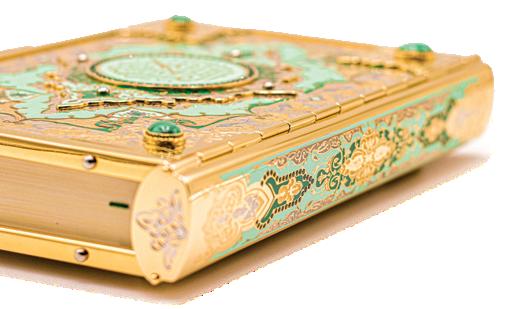
Religion is a form of consciousness, and in the world of art, religious motifs are a source of deep inspiration. They give birth to works that are incredibly strong in their emotional content and possess deep hidden symbolism.
The Koran and rosary are kept in a leather casket richly decorated with ornaments that have aesthetic and practical meaning. The clasp and protective corners are made of bronze with a repetitive ornament - arabesque. Since the art of Islam is almost always not pictorial but abstract and ornamental, the leading role in Arab culture belongs to ornamentation, which is reflected by the artist both on the Koran itself and on the box.
The characteristic features of Arabic ornaments are amazing decorativeness, splendor and luxury. Sergey Denisov has managed to convey all these features and put into a complex, ornate, elegantly intertwined motif the subtle meaning inherent in arabesque - the pattern seems to go into infinity, reminding of where we will all go and the primacy of eternal values over the material world.
In the continuous repetition of motifs there are two main elements: interlacing and plant leitmotif. Depicted in green, the most revered color among Muslims, they symbolize nature and life. The alpanite faceting and malachite underline the supremacy of green, the traditional color of Islam.
In the center of the Koran and the box, Al Qurani Karim (the Holy Koran) is written in Arabic script using the principle of two dimensions - vertical, which gives the letters nobility, and horizontal, which unites them in a continuous flow.
With the help of amazingly beautiful Arabic calligraphy, not only the high spiritual meaning of the Koran is conveyed. Each page reflects elegance and aestheticsvertical lines symbolize the essence of things, horizontal lines symbolize the matter that binds things together into a single space.
The Koran in such an artistic execution evokes not only high aesthetic feelings, but also pleasant tactile sensations, emphasizing with its weight the importance of the book you hold in your hands and can pass on to your descendants as the main spiritual treasure.
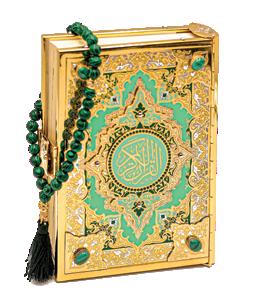
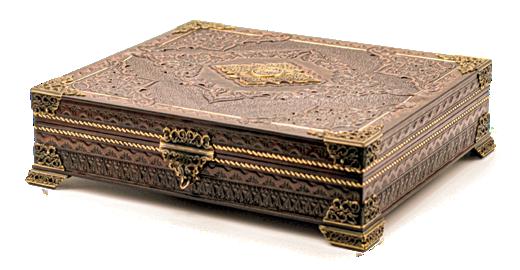
MATERIALS:
KAMCHA
Sergey Denisov shares his worldview, his view on art and life in general, and every journey of the artist is reflected in his works. Having lived in Kazakhstan for more than 7 years, the master was inspired by the traditions, culture and rich history of this original and unique country and, wishing to tell the world about them, created a number of products telling about the life of nomads. One of these items is a one-of-a-kind kamcha, made in a single copy.
Being a rather rational people, Kazakhs created multifunctional household items. One of such items is the kamcha. Kamcha is a whip, which has a special meaning and value for nomadic people. However, the kamcha was not only used to chase horses, sometimes it became a weapon and even a means of non-verbal communication.
The kamcha could be used to demonstrate one's attitude to a situation, one's intention or one's mood. So, it was enough to rest the kamcha to his side to show without further ado that the conversation was over. By getting down on one knee and resting the kamcha on the ground, a man said that he had brought important news. Throwing a kamcha on the ground, depending on the situation, could be a call to action, a message of readiness for confrontation, and a sign to give a word or stop speech during the trial of biys. For centuries, the kamcha was a symbol of power, strength and embodiment of the resolute character of nomads.
Traditionally, the Kazakh kamcha was woven from leather, and the handle was made of wood. To show the status of the owner of a kamcha in society, the handle was inlaid with silver. A piece of lead or a stone was attached to the end of a kamcha intended for hunting.
Wishing to preserve the traditions of nomads and pass on the memory of their greatness, Denisov Art Studio created a kamcha in Kazakh style.
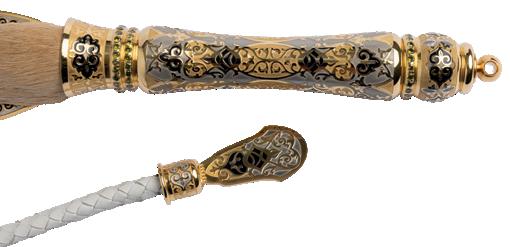
Wishing to preserve the traditions of nomads and pass on the memory of their greatness, Denisov Art Studio created a kamcha in Kazakh style.
The broad platform of the kamcha depicts a hunting scene. Berkutchi and his faithful pup golden eagle demonstrate one of the main occupations of the nomadic people and at the same time without words inform about the purpose of the kamcha, the leather whip of which ends with a bronze tip decorated with the same patterns as the handle.
Kazakh ornamentation decorating the handle, base and tip of the kamcha is an important design element, reflecting the rich cultural heritage of the people. The pattern resembling rounded ram's horns is one of the oldest. It dates back to the Scytho-Saxon culture of VII-III centuries B.C. In Kazakh ornamentalism it is a fundamental element, a symbol of the divine beginning, closeness and power.
The image of this element, which also means vitality and prosperity, on black enamel (black is the colour of earth, sacred among Kazakhs) doubly strengthens its properties and promises the owner of kamcha prosperity and longevity.
Kazakh ornaments depicted on a white background, symbolizing purity, goodness and nobility, have an almost mystical power, protecting the owner of the kamcha and attracting favorable circumstances into his life.
The base of the handle, decorated with gently shimmering olive-green chrysolites, forms a ring that recalls the cyclical nature of life and harmony with the world around us.
Jades symbolize incorruptible power, courage, strength, wisdom and immortality, giving this work of art a sacred character.
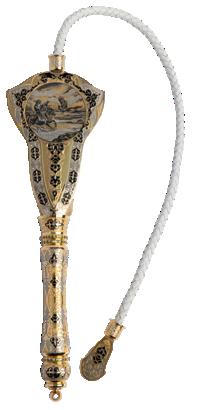

MATERIALS:
Bronze, gold plated, silver plated, jade, chrysolite, leather.
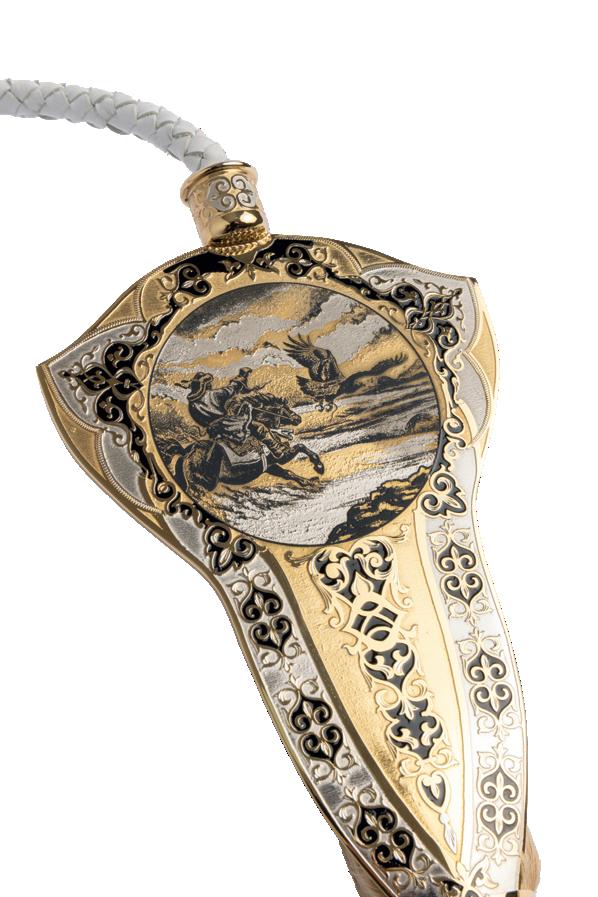
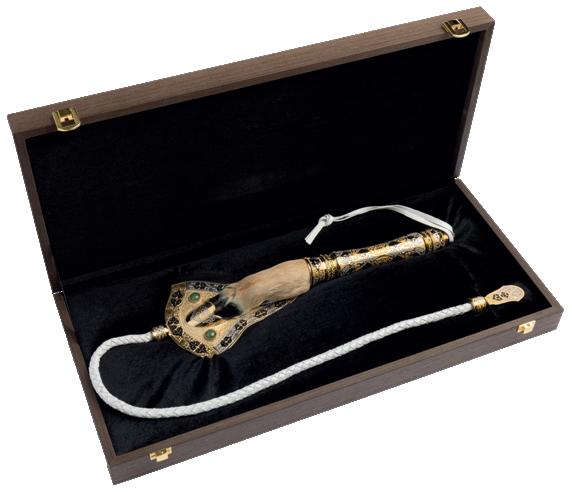


HUNTING THE ARGALI
The artist Sergey Denisov was inspired to create this work of art by the material itself. The horn of the argali, given as a gift to the master, turned into an amazing work of art. The material dictated its own conditions - the outwardly static piece had to convey the dynamics of the hunt. At the same time, the master wanted the piece to express not only its aesthetic component, but also its practical meaning. It took several years for the idea to be physically embodied and turned into an interior decoration with a utilitarian value.
Many years ago, hunting was not an entertainment, but a man's daily activity, important and necessary, especially in the mountains and steppes. On his agility, endurance and courage depended the well-being of his family and kin.
Modern life does not require such efforts, but in men's genes the hunter's passion still manifests itself and requires an outlet. The most harmless and aesthetically attractive way - contemplating works of art with scenes of hunting and collecting edged weapons.
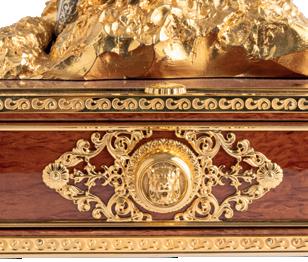
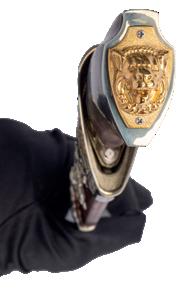
The table composition «Hunting the argali» will allow its owner to become both a contemplator and a collector. Its uniqueness is in the movement, which gives the static product dynamics. Thanks to this effect, we turn from ordinary spectators into witnesses of the hunt, feeling the power of animals, the speed of the chase and excitement - is the outcome already decided or is there still a chance to miss the prey?
The material for the hunting scene was the horn of the argali. The base for the knife is a stylized rock made of bronze and covered with gold. The knife in the scabbard balances the composition and is its center, being an invariable attribute of the hunter. Strict and laconic ornament adorns the product and emphasizes the minimalism and asceticism inherent in male hunters.
The casket, made of Karelian birch and decorated with gilded bronze volumetric elements, has quite a utilitarian purpose, you can put in it important papers, and perhaps a mobile phone, which for a modern man is as important as a dagger for our ancestors-hunters.
The scabbard and hilt of the knife are also made of Karelian birch and decorated with carved Melchior overlays. Decorated with agate and stylish pattern, the knife will emphasize the status of the owner, and the ability to appreciate the perfect balance of gilding and muted shades of wood will "tell" about his impeccable artistic taste, allowing him to understand the harmony of color and style.
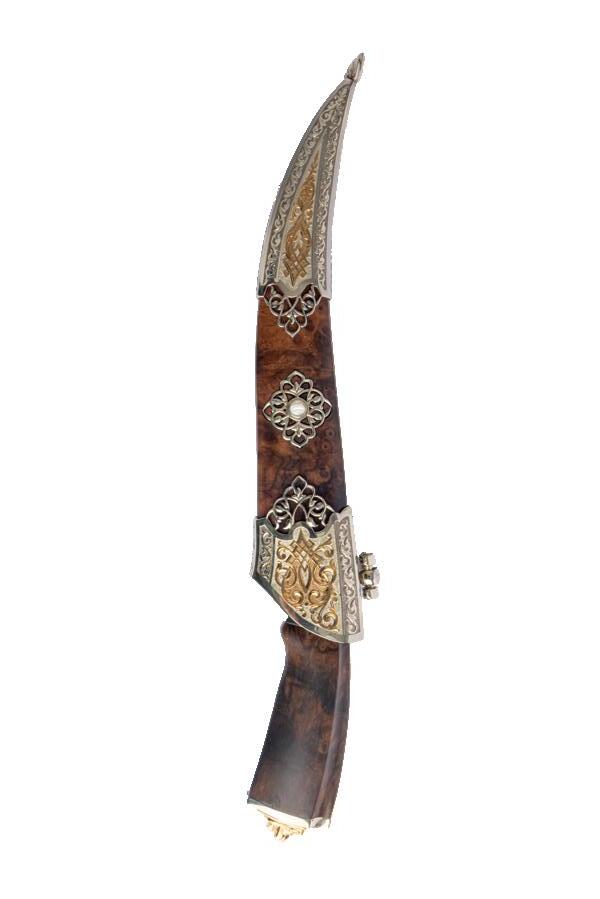
Its uniqueness is in the movement, which gives the static product dynamics.
MATERIALS:
bronze, neisilber, high-alloy steel 110Х18, Karelian birch, agate, argali horn, gold plating. Made in a single copy at the highest artistic and technological level, the composition «Hunting the argali» will become an exclusive decoration of the cabinet of a respectable man who understands and appreciates the craftsmanship and multifaceted meaning contained in this work of art.
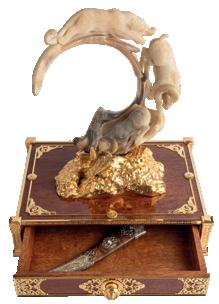
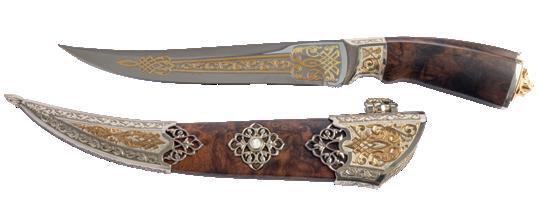


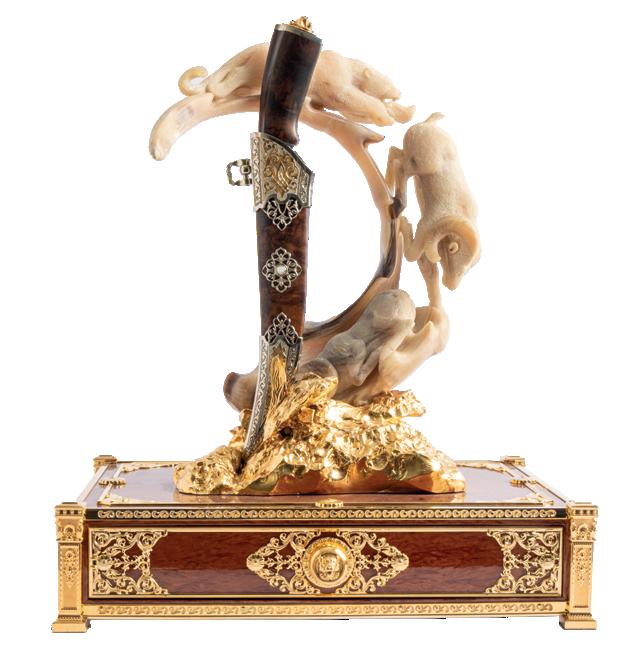



denisov-art.com
info@denisov-art.com
Kazakhstan, Almaty, Kunaev Street 181B, office 308. +7
